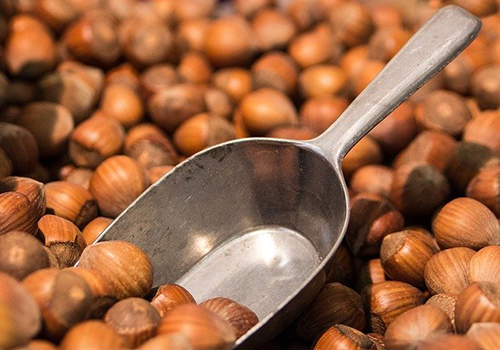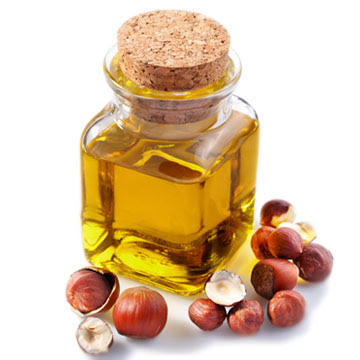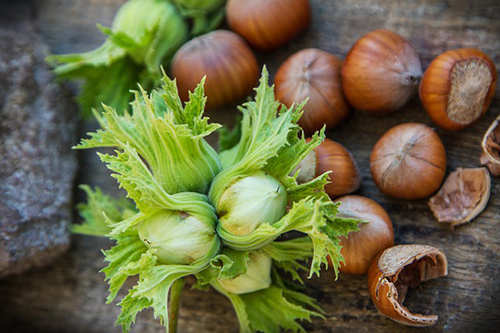Contents
The hazelnut benefits are many. Wild hazelnut forests exist in mountainous and wet regions where squirrels enjoy a true paradise. In September and October, these trees offer walkers their tasteful fruits equal to farmed hazelnuts.
In the 1st century A.D., Dioscorides already recommended it for respiratory diseases, although he knew eating too many could be heavy on the stomach. Saint Hildegard recommended it for the treatment of male impotence. Mattioli, an outstanding Italian physician of the 16th century, applied it in lotions, ground it, and mixed it with bear fat as a hair-growth product.
Since then, many other applications have been given hazelnuts. The most outstanding is calming nerves and preventing the formation of kidney stones. Notwithstanding, none of these benefits has been proven. However, one thing is true: They are excellent food, rich in lipids (62%), proteins (14%), mineral salts, and vitamins. Therefore, those wishing to gain weight and whose digestive system works well should take 12 to 15 hazelnuts daily as a dessert.
We have not forgotten that several parts of the hazelnut tree have interesting medicinal effects.

Benefits, Healing Properties, and Uses
All parts of the tree contain flavonoids and tannins. The BARK of young branches and the leaves have the following applications:

- Venotonic: Its most notable effect is improving venous blood flow, thus boosting blood return to the heart. A decoction of bark and leaves, both taken and applied in compresses on the legs, is recommended for varicose veins, phlebitis, and hemorrhoids. It also has a mild vasoconstrictive and hemostatic effect; thus, it can be equally employed for epistaxis (nose bleeding) and hypermenorrhea (excessive menstruation).
- Cicatrizant: When used externally, it can be used as a wound healer. It is also helpful for torpid wounds and varicose ulcerations. The hazelnut tree has a notable sedative and anti-inflammatory effect on hemorrhoids. It can be applied as a decoction in compresses, sitz baths, or drunk.
Its AMENTS (flower spikes) and its pollen, gathered in Spring, have the following:
- It is depurative, sudorific, and febrifuge, accelerating healing for influenza or colds. It also controls obesity, cleanses the body, and provokes weight loss through sweat.
Hazelnut fruits are used as food. They are rich in calories and nutritious substances (fats and proteins). To achieve optimum assimilation, they must be well-chewed or ground, forming a puree if necessary. They have a mild hypertensive effect (increasing blood pressure), so people suffering from high blood pressure must not abuse them.
Hazelnut OIL is astringent and closes skin pores. It is recommended for greasy skin and acne.
Hazelnut Scientific Facts
- Other names: Cob nut tree.
- French: Noiseter.
- Spanish: Avellano.
- Environment: It grows wild in mountainous regions of Europe and North America. It is farmed in Mediterranean countries.
- Description: Shrub or tree of the Betulaceae family, growing from two to five meters high. It is usually formed by multiple stems which grow from a joint base. The leaves are toothed, and their end is pointed.
- The parts of the plant used medicinally are the aments (spiked flower clusters), the bark of young branches, the leaves, and the fruits (hazelnuts).

How To Use
- Decoction of the leaves and the bark of young branches (mixed): 30-40 g per liter of water. Boil for three minutes and steep for 15. Drink one or two cups daily.
- Decoction of aments (sudorific, slimming). Fifty grams of Spring aments per liter of water. Boil for five minutes and steep for 15 minutes before straining. Drink one cup after each meal.
- Hazelnut fruits. A handful at breakfast or after lunch.
- Compresses, with the same decoction of bark and leaves employed for internal use, soak compresses applied on the afflicted areas.
- Sitz baths, also with this decoction.
- Massage on the skin with hazelnut oil.
DISCLAIMER: All content on this website is presented solely for educational and informational objectives. Do not rely on the information provided as a replacement for advice, diagnosis, or treatment from a qualified medical expert. If you are pregnant, nursing, or have any preexisting medical concerns, talk to your doctor before using any herbal or natural medicines.
REFERENCES
- George D. Pamplona-Roger, M.D. “Encyclopedia of Medicinal Plants.” George D. Pamplona-Roger, M.D. Encyclopedia of Medicinal Plants. Ed. Francesc X. Gelabert. Vols. 1 San Fernando de Henares: Editorial Safeliz, 2000. 253, 254. Print. [hazelnut benefits]
- https://www.arborday.org/programs/hazelnuts/consortium/nutrition.cfm
- https://www.verywellhealth.com/hazelnut-8402052
